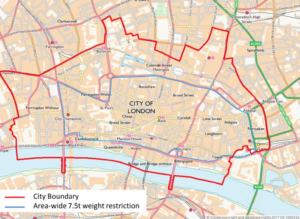The City of London Planning Document for freight and services provides additional guidance on the interpretation of policies in the City of London Local Plan in relation to freight and servicing movements in the so-called Square Mile.
Growing demand for goods and services
The efficient movement of goods and services are fundamental requirements for a successful city. While electronic services and communication have revolutionized working practices and removed the demand for the movement of some goods and services, other new areas of demand have grown.
Despite the small footprint of the City of London, the large working population generates significant demand for physical goods and services. Employment in the City is forecast to grow from 487,000 in 2015 to 569,000 in 2036 so the need to manage the increasing demand for space on the transport network continues to grow.
Growing number of delivery vans and trucks
Throughout a typical weekday, around 22% of traffic in the City of London is goods vehicles, with the majority of these being Light Goods Vehicles (LGV) under 3.5 tonnes. In Greater London, Transport for London (TfL) forecasts that trips made by vans will increase by 26 percent by 2031, representing 77 percent of the total forecast growth in vehicle trips.
Delivery and Servicing Plan (DSP)
The planning document sets out potential measures for managing freight through the planning process by minimizing trips, matching freight demand to network capacity, and mitigating the impact of essential freight trips. Increased use of smart technologies may impact on the possibilities for managing freight movements in urban environments. The efficient coordination of deliveries through technology and data is becoming increasingly important in the freight sector and may present new opportunities for managing the impacts of delivery and servicing.
The single most effective way of proactively managing delivery and servicing arrangements is through a Delivery and Servicing Plan (DSP). For buildings over 1000sqm or where the development is likely to have a significant impact on the transport network, the Local Plan requires a DSP as a planning condition. Where it is not required, the development of a DSP can lower delivery costs and impacts and is strongly encouraged to effectively manage delivery and servicing movements associated with the site.
The planning document provides guidelines for facility management (also for multi-tenant buildings), waste management, food and drinks, and construction logistics.
Source: City of London

